
Many owners of a mustachioed and furry miracle, when deciding how to get fleas out of a cat, often try to find a remedy that will help solve the problem forever. Of course, such searches are initially doomed to failure: even a remedy that provides complete disposal of fleas in cats cannot guarantee that in a week or a month the pet will not pick up parasites on the street, or the insect will not jump on it by accident, being brought from the street to owner's clothes.
But to rid a cat of fleas once is quite simple: today for this there is a huge number of various means and preparations that work quite effectively and are available to almost everyone.
The entire operation to rid the pet of parasites should be carried out in several steps, each of which is important and necessary.
So, even before removing fleas from cats, you need to accurately determine that the pet is worried about fleas, and not other parasites ...
Step 1. Determine that the cat really has fleas
Among other skin parasites of cats, fleas are distinguished by several features that can be used to determine exactly what they are.
Sign 1 - itching in the animal and constant combing of the body on the back and sides.If a cat is bothered by ticks, she will try to comb behind her ears or bite parasites in her groin, which are where ticks bite most often. In fleas, however, such gravity is not observed: they bite with the same desire for any part of the body.
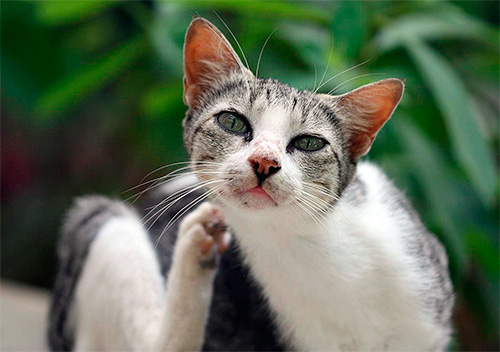
Sign 2 - excrement and flea eggs on the body of an animal. To notice them, you should push the coat and carefully look at the skin of the pet. If small black dots (excrement) or white dots (eggs) are visible between the hairs, it means that adult parasites are definitely present in the cat.
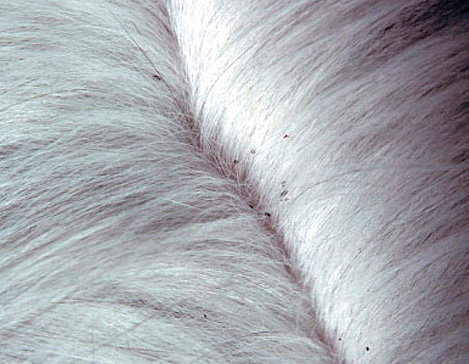

Sign 3 - the appearance of noticeable skin irritations. Flea bites cause itching and local allergic reactions in cats, and in some animals they can lead to dermatitis, eczema and, in the rarest cases, anemia. Of course, it is necessary to remove fleas from a cat long before the appearance of such symptoms.
…5 (allergic dermatitis to flea bites)
Sign 4 - visual detection of the fleas themselves. Fleas are easily recognizable insects, although they are very small. They have a rounded body up to half a millimeter long and faintly visible long legs, with which they can make very large jumps.
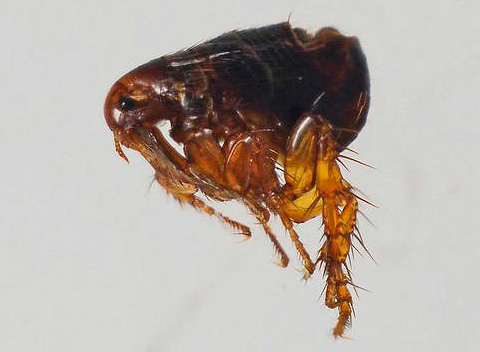
You can find them on the body of a cat by parting the hair or combing the animal. In addition, these insects will actively jump off the pet while bathing - no other parasites can do this.
Many people know how to catch a flea from a cat, but keep in mind that in addition to fleas, there are also their eggs, so it’s unlikely that you can manually transfer all the parasites.
The presence of at least one of the above signs indicates that now you should start thinking about how and with what to remove fleas from a cat. To do this, you need to choose an effective and safe drug.
Step 2. Apply an effective flea remedy
Removal of fleas in cats today is carried out using means that are different both in their appearance and in the mode of action. They have one thing in common: rather powerful insecticides act against insects in all these products - insect poisons - which at the same time turn out to be not too dangerous for the cats themselves.
All these funds are divided into several groups.
Flea drops
Flea drops are popular remedies today that combine effectiveness and ease of use. The composition of these preparations includes an aqueous solution of one or another insecticide, which not only kills insects, but also repels them with a smell. Due to this, applying a few drops to the neck or back area provides a stampede of parasites from the body of the animal.

Before you fight fleas in cats with drops, you must first read the instructions for using the drug itself: the drops can be applied in different ways and be quite toxic to kittens or pregnant cats.
The most popular of the drops today are the following:
- Hartz is an American remedy, very effective even against flea larvae, which is why it is often used after the use of less expensive drugs that kill adults.
- Drops Frontline Spot on Cat, completely ridding the pet of fleas within 24 hours.
- Bayer Advocate, with which not only the fight against fleas in cats is carried out, but also the prevention of helminthic invasions and tick infestations.
- Leopard, a domestic remedy, is notable for the fact that, unlike foreign analogues, it is applied not to the withers of the animal, but in several places along the spine.
Flea control in cats with drops is the best solution for those animals that mainly live indoors, but for several months or weeks they go with their owners to the country house or other place where they spend a lot of time in nature. It is worthwhile to treat a cat with drops here literally several times over the entire period in order to protect it from infection and get rid of those parasites that have already attacked it.
Flea collars
The optimal solution for animals that regularly and a lot of being on the street. They protect the cat for two months, are low toxic and help well in cases where it is necessary to remove fleas from a pregnant cat. Their main drawback is the possibility of developing dermatitis in an animal on the neck.
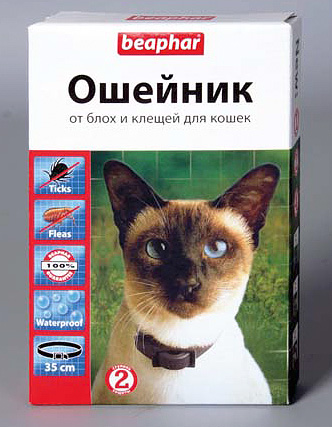
Important advantages include the fact that with such a collar, a pet walking freely on the street is protected not only from fleas, but also from teams that catch homeless animals: the presence of any collar on an animal is evidence that it has owners and is not homeless.
Sprays for cats
It's kind of a radical way. Coat sprays are highly toxic to the animal itself and should be used exactly as directed and only on cats that do not come into contact with kittens or other cats.

It is forbidden to use sprays for nursing cats. As a rule, they are used to combat parasites only in severely neglected cases.
Of the sprays, mostly the same brands as the brands of drops are popular - Hartz, Frontline, Bayer, Bolfo - preparations from the same manufacturer contain the same insecticides, and therefore work well in different forms of release.
Flea shampoos
In cats, this type of flea remedy has taken root less than in dogs, but, nevertheless, is used quite often. The main advantage of shampoos is their safety. The bathed pet completely gets rid of fleas, and after the main bathing procedure, a thorough washing of the coat follows, as a result of which the shampoo is completely washed off.
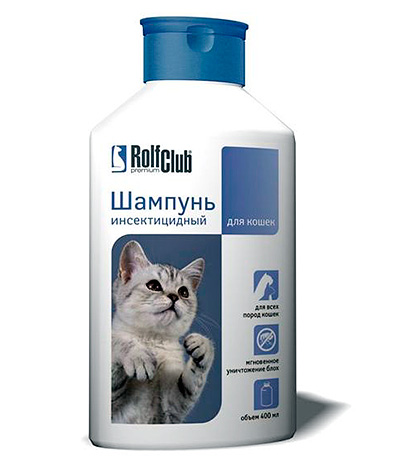
After bathing, the cat cannot lick the drug itself, and neither can her kittens.
Popular shampoos are Advantage, Advantix, Lawyer, Russian 4 with a ponytail. When deciding what is the best way to wash a cat from fleas, you should ask the owners of cats of the same breed: for long-haired animals, more effective shampoos will differ from those for short-haired ones.
Flea injections
Flea injections for cats are a remedy that allows you to quickly remove parasites, but difficult to use. Few of the owners can make injections on their own, and it is irrational to take the animal to the clinic for this.

However, injections help to remove fleas from a cat, even actively communicating with heavily infected animals. Moreover, these same other animals will not be poisoned by the treated pet in any way (which can happen, for example, in the case of using sprays or, less often, flea drops).
Flea injections should not be given to lactating and pregnant cats: the active ingredient of the drug may affect kittens.
Flea tablets
Flea pills work in much the same way as injections, but are easier to use. They allow you to effectively remove insects, but often cause side effects in animals, for which cat owners do not like them.

When deciding to remove fleas from a cat with tablets, you should consult a veterinarian.For each remedy, a particular animal may be hypersensitive, and what is most suitable according to the descriptions may have an individual intolerance.
Step 3. Eliminate the consequences of infection
The main problems with flea infestation in cats are:
- itching
- allergic reactions and skin diseases
- helminthic infestations (fleas are carriers of helminth eggs).
All of them require different approaches to treatment.
To get rid of itching, baths are used on special herbal infusions or with the addition of sedatives, with point lesions - skin treatment with analgesics. In case of allergic reactions, depending on the degree of their manifestation, either special antihistamines or complex sedatives are used.
Skin diseases require treatment in a veterinary clinic, and measures to combat worms are regular dressings.
Step 4. Prevention of subsequent infections
As all doctors assure - including veterinarians - the prevention of a disease is always easier and more effective than its treatment. If you do not give fleas the opportunity to infect a pet, then in the future you will not have to solve the problem of how to get them out.
Prevention measures:
- prevention of pet contact with street and obviously infected animals;
- regularly treat animal household items with boiling water - bedding, toilet, sleeping basket;
- at least once a month, carry out wet cleaning in the apartment with the addition of insecticides and acaricides to the water;
- avoid contact with other animals, and upon arrival home - wash your hands, shake out clothes and shoes outside the apartment.
It is quite troublesome to follow such rules, but the result will be the cleanliness of the pet and the absence of problems with infecting it with fleas.



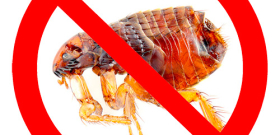
Collars help, but they need to be changed often or soaked in infusion of celandine and other herbs. But it is necessary to accustom to any collar gradually, without leading to a violent reaction. And then the animal will shy away all its life and not trust the one who brought it to such a shock and, perhaps, will start biting and scratching - this may be the reaction for the rest of its life to the collar, and to everything that causes severe irritation ... It is necessary put on for 1 minute and look at the reaction, try to distract with a game or a tasty treat. If the animal cannot distract from the problem in any way, then you need to take it off and let it calm down, and after some time try again, but playing with it, distracting it ... It will gradually get used to it, but you need to have patience, as in everything in life! And it happens that the animal suffers, not finding a way out of the situation, trying to remove the collar. And cruel owners will then receive an inadequate animal: vicious and biting. Everything is fair!
I will not dare to hurt my cat (that is, an injection).
Interesting, but how do you vaccinate? Or does it hurt too?
And I…
I now have a very acute problem with fleas. Because I have six adult cats and six foundling kittens. Bars used to make her own pipettes, but this year the drug has deteriorated. And with so many animals, you can’t really pull on expensive funds. I would still like to learn more about injections. How harmful, how long they act, whether it is possible to make them weakened, finally, I would like to know the names of the drug. We make our own.
I have kittens, your injection will not help my kittens, it will only hurt.
We don’t get anything, sorry poor animal! I do not know what to do.
And we don't get anything! First, they dug "Bars" - they did not leave. You can’t drip again, I bathed in shampoo and put on a Bifar collar, it smells strongly of lavender. But they, fleas, see, anyway!
So why did you bathe after the drops? You can't swim for 3 days.
Same problem. A bunch of money down the drain. And mine loves to climb in the garden, and even a lot of wool.
We, too, cannot get these damned fleas out in any way ... We don’t know exactly what to do.
How often can you bathe a cat? Help him a little.
Stronghold really helps
Shampoos are generally ineffective, absolutely none! And drops too. I struggled all winter, now they also wound up in the apartment ...
Make dichlorvos, it helps a lot. And then you can scatter wormwood (preferably fresh) around the apartment.
Tell me, what injections are needed? Already there are no forces - and shampoos, and drops, and sprays, and collars ... Everything is useless.
Wormwood tincture. Sold in any pharmacy. I diluted it with water and sprinkled it on the cat + treated the entire apartment with this liquid, including furniture.
In what proportions were they diluted? And how was the cat treated?
Tell me, did wormwood help against fleas? Nothing can be brought out. Both the cat and the kitten are constantly outside.
Wormwood did not help, tried.
We have been taking the cat to the dacha for a year now in the summer. And she likes it there, and we are calm - the beast is still under supervision, and besides, it’s not left for anyone to look after, feed, etc. We use a flea collar and spray spray. Helps.
Sagebrush?